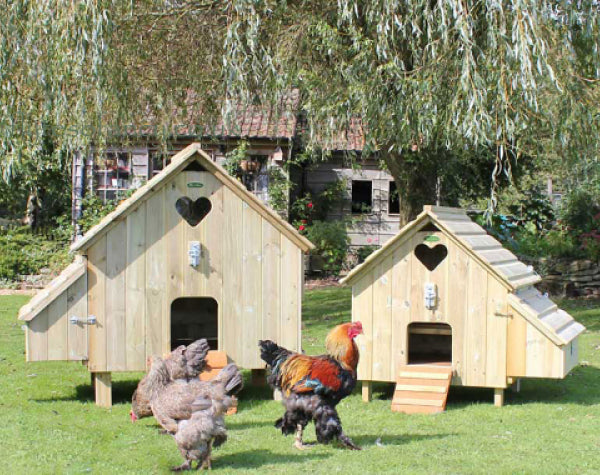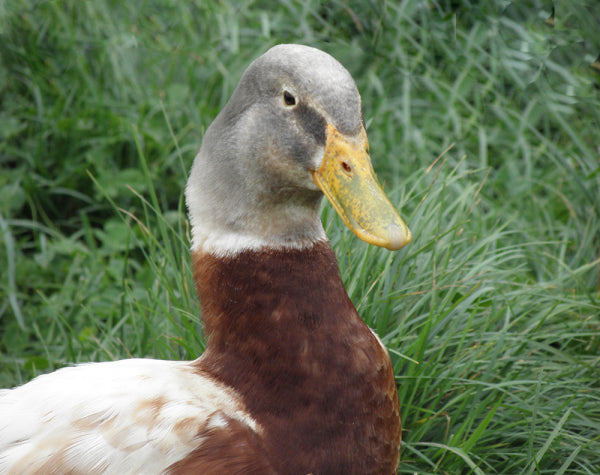Frequently Asked Questions about Chickens and their Houses
How do you stop a broody hen being broody?
There are a number of ideas, tips and tricks that we have heard over the years, some of them quite bizarre, but we have found the most effective is the 'bucket of water'.
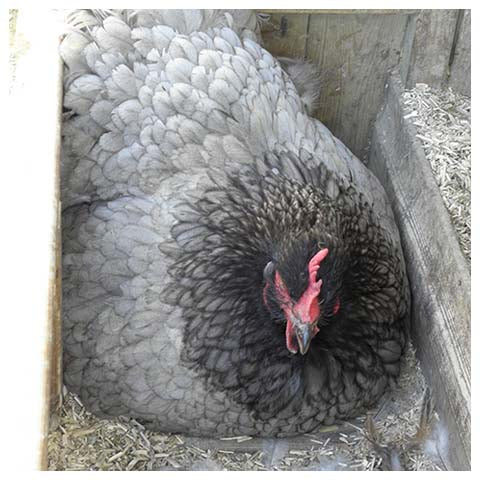
Don't worry, it's not as cruel as it sounds. The reason the girls go broody is because the heat in their body increases ready to incubate a clutch of eggs which triggers a brooding instinct so, the theory is, take the heat out of her chest/body and the instinct goes away.
Bravery is required as she will probably peck at you when you approach but, take hold of her by placing hands on either side of her body to hold the wings in place. Gently ease her into your vessel of water (this must be tepid water, not 'iced'), feet first, until the water reaches her chest area. Hold her there for about 30 seconds, then gently take her out again (dry her off a little if you wish). Place her gently back on the ground.
You may have to do this several times until the heat goes from her breast but honestly, it will work. Please do note though, not cold water, it must be the same temperature as your hand, otherwise shock sets in.
Another option, beloved of old traditional keepers, is to place her in crate with a wire mesh floor, no bedding. This will allow the air to circulate around her body and reduce the heat. Alternatively, try replacing real eggs with dummy rubber eggs, theoretically, she then gives up.
HELP! Red Mite again! At my wits end! I've tried everything! How do I get rid of Chicken Red Mite?
Well, if natural products like Poultry Shield and Diatomaceous Earth (DE) haven't worked for you, the next step is a Smoke Bomb and Net-tex Total Mite Kill Aerosol Spray.
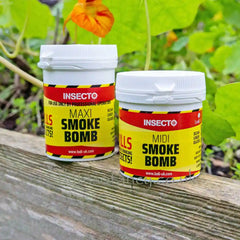
Chicken House Fumers are smoke bombs that you ignite inside a closed henhouse (birds excluded from the house of course) and allow the fumes to do their work for approx 2 hours. Follow this up with the aerosol mentioned above sprayed on to perches and corners where they hide.
If all else fails then opt for the nuclear option which is Ardap Spray, this contains Permethrin and Cypermethrin but with its residual properties, it does the job for up to six weeks (mask and gloves advised).
My girls have messy bottoms and runny poo, what would cause this?
Several things could be the cause. Worms is the first thing to check, have you wormed them recently? Secondly, what are you feeding them?
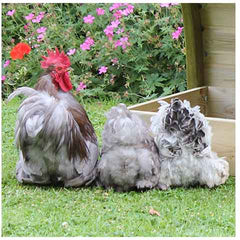
If you are giving too many treats, like sweetcorn, cabbage or sunflower hearts, it can give them diarrhoea.
Staple diet should be layers pellets but, like children being offered a choice of ice cream or vegetables, they will take the treat in preference.
For more information on poultry worms check our How to Treat and Prevent Poultry Worms page.
What is 'egg withdrawal'?
When giving birds a medication, anti-biotic or some worming solutions, then you would be advised about an 'egg withdrawal period' by your Vet. This means that you should not eat the eggs being laid for a period of time, you should discard them until the period is up.
Sprinkling the birds with a powder does not require an egg withdrawal period, usually only actual medications carry this advice. If in doubt ask your vet.
What is the best bedding to use for poultry?
Historically, straw has always been used because it was so readily available on farms and easily broken down in compost. Then came woodshavings which were much more pleasant to deal with, kept the eggs cleaner, is softer for the birds and easier to clean out but, it didn't break down quite so quickly in the compost heap.

The proliferation of red mite has, though, made straw a bit of a no-no for us keepers, with its tubular nature it is a perfect place for these dreaded mites to hide.
Today, we can definitely recommend Chopped Hemp Bedding as an almost perfect solution and many, many poultry keepers have been converted to this form of bedding for use both in the nest boxes and on the floor of the house.
Chopped Hemp has terrific absorbency, reduces the acrid ammonia smell of the henhouse and is soft for the birds. It breaks down on the compost really well and is eco-friendly because it is a bio-degradable natural plant product. We can recommend our own brand HempBed-E Poultry Bedding with eucalyptus or Aubiose hemp bedding.
Is the timber you use to make your Hen Houses pressure-treated?
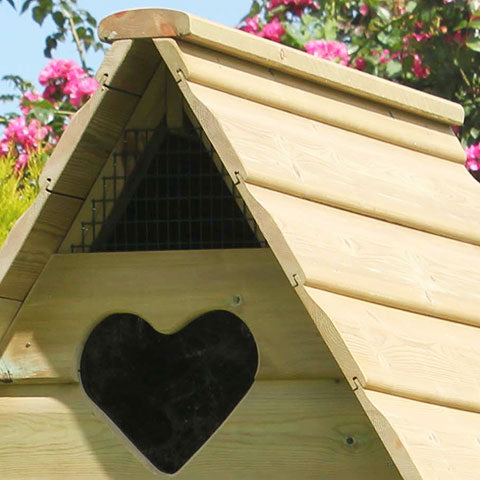
Yes, it is. All the timber we use is Scandinavian Redwood, FSC Certified Sustainable, which is pressure treated with eco-friendly Tanalith-E and all cut ends are finished with a sealer by us after construction.
For more details of all the timber and fixings we use, see About our Housing. And for an understanding of the timber and how to take care of it, see also our information on Pressure Treated Timber, which includes Warranty information.
Can the hens get out through the heart window in your henhouses or other creatures get in?
No. The heart is a sealed window covered with polycarbonate, not a hole. It is not essential, it just lets light in and allows you to view the birds inside without opening the door.
Do I have to have the heart window in my Flyte so Fancy house?
No, not at all. Not everyone wants a heart window and many prefer to keep the henhouse quite dark inside - you just have to let us know when ordering that you prefer no heart decoration. We do also offer a Chicken window option in the chicken coop section.
Is it necessary to keep a cockerel?
No, it isn't. The hens will lay eggs and do all-natural things very well without one. You would need a cockerel if you intend to breed from them of course, but as you can buy fertile eggs easily these days even that is not necessary.
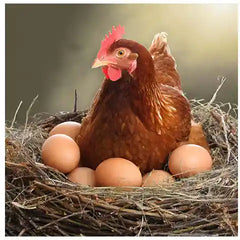
Further reading on our blog page How a hen makes and egg.
Cockerels are very useful to keep a flock 'in order' and thereby will prevent any feather pecking - which is common amongst hen-only flocks.
Cockerels are beautiful birds and like to 'look after' their girls but, they crow loudly; the neighbours will complain; they can hurt the girls through over-zealous mating; they can be aggressive towards you and jump up at you when you are close; they can't protect the hens against the fox.
How much food and water do chickens need?
We suggest allowing the following amounts per bird, per day, for laying hens:
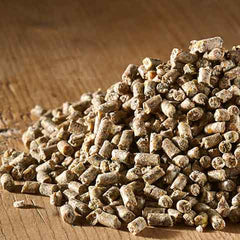
150g Layers Pellets
20g Mixed Corn
300ml Clean Fresh Water
Perhaps allow more water in hot weather and do make sure, in very cold weather, you regularly check that water is not frozen or, put drinker inside the coop to keep it ice-free.
This average does depend on the size of bird - for Bantams it would be less, for large fowl it would be a little more - and whether they free-range or spend their day in an enclosed area, as well as the time of year.
Do chickens need grit and oyster shell?
Chickens need to take in grit to help digest their food. The sharp flint grit helps to grind down the food the hens eat because as everyone knows, chickens don't have teeth (hence the term 'as rare as hens teeth'!).
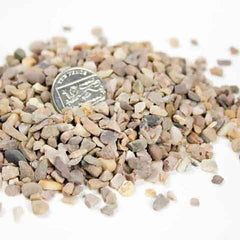
If your hens free-range then it is likely that they already get enough grit in their diet through scratching the ground. However, if they are confined to a run you should provide a Poultry Flint Grit and Oyster Shell, this can be bought as either a Mixed Poultry Grit or separately (see Grit & Oystershell for options).
Oyster Shell provides soluble calcium - they need calcium to form the shells on their eggs so if they are calcium deficient you will get soft eggs or eggs with no shell. This will help them lay hard-shelled eggs and is an essential part of their diet. Some poultry feeds already include a mix of grit and shell e.g. Smallholder Super Mixed Corn.
For a more instant solution try a liquid Calcium Supplement like Cal-Boost Poultry Calcium Liquid which would give the birds a far more rapid uptake to repair any skeletal damage or solve an eggshell problem.
Where can I get some chicks/hens from?
Take a look in specialist magazines such as Country Smallholding or Practical Poultry as they contain Breeders Directories. Look for one or two locally that you can visit to view the birds and talk to the breeder.
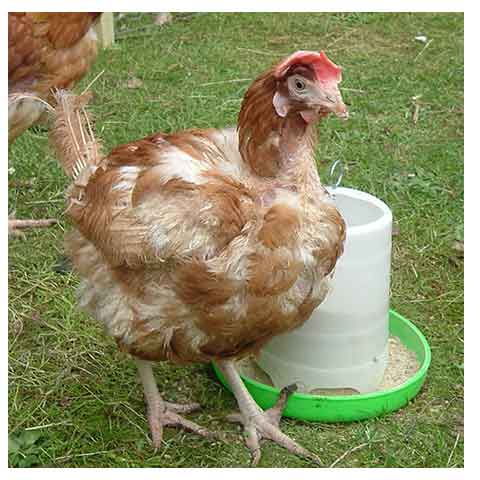
Make sure the birds are vaccinated for Mareks Disease and Newcastle Disease. Please do not buy from auctions/local ads unless you are experienced and know what to look for.
Taking in ex-battery/ex-cage hens is wonderfully idealistic and satisfying - see our BHWT page. We would advise that, if you are new to poultry keeping, you research as much as possible and are aware of the extra care needed with rescue hens. They can arrive with many psychological problems, and sometimes need a lot of nursing - they often have few 'chicken' instincts.
Which is best, a timber hen house or plastic?
Obviously, we would sound prejudiced on this subject because we prefer timber housing, as well as being a manufacturer of many designs, we prefer natural materials. We would say, looking from an eco-friendly point of view, a plastic house is probably not good for the environment, being ostensibly made from petro-chemicals, they (usually) cannot be recycled and end up in landfill.

So, let me just quote from an article by the late Katie Thear, beloved authority and bestselling author of many books on all things chicken, about a plastic hen house she 'road tested' several years ago ...
"Its advantages were that it was light, easy to move about and to clean. Its disadvantages were numerous: Unless tied down in some way, the house was easily blown over in high winds. In winter, its lack of insulation meant that the chickens were obviously cold at night because they were huddled together in a tightly packed ball of feathers. In warm weather, the interior became so hot that they wouldn't go inside. Condensation was also a problem because, unlike wood, plastic does not breathe. Despite having ventilation apertures, there were still drops of moisture running down the inside walls. Lack of ventilation and a build-up of humidity encourage lung problems and the spread of infections.
I'd advise any readers thinking of buying one to first check with the manufacturer:
- How the price compares with the same sized wooden house
- What the price is without extras such as chickens, feeders etc.
- What the price is with and without an attached run
- If chickens are included, what breed or type are they? How old are they? Have they come from a registered flock where vaccinations have been administered?
- How stable is the house in high winds
- How effective is the insulation in winter and summer
- How is it ventilated, and can the ventilation be controlled?
- Is it equipped with perches, pop-hole and a nest-box that can be accessed from the outside?"
Katie Thear, Published in Country Smallholding Magazine Sept 2007. Reprinted with her kind permission.
And finally ...
If you have any questions about chicken keeping, or about our products, which we have not answered here or on our information pages then please Message Us.

